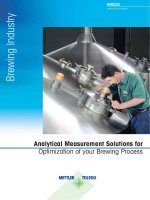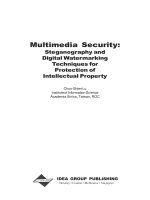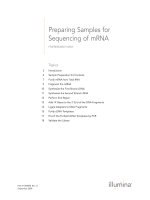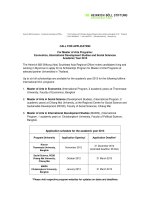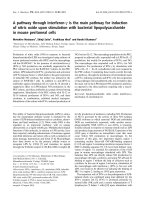- Trang chủ >>
- Mầm non - Tiểu học >>
- Lớp 1
Crystallization Pathway for Crystallization of FeB Nanoparticles
Bạn đang xem bản rút gọn của tài liệu. Xem và tải ngay bản đầy đủ của tài liệu tại đây (777.39 KB, 8 trang )
<span class='text_page_counter'>(1)</span><div class='page_container' data-page=1>
80
Original Article
Crystallization Pathway for Crystallization of FeB Nanoparticles
Pham Huu Kien
*<sub>, Pham Mai An, Nguyen Hong Linh, Giap Thuy Trang </sub>
<i> Thai Nguyen University of Education, 28 Luong Ngoc Quyen, Thai Nguyen, Vietnam </i>
Received 08 April 2019
Revised 04 June 2019; Accepted 18 July 2019
<b>Abstract: The FeB nanoparticle (NP) consisting of 5000 particles (4500 Fe atoms and 500 B </b>
atoms) has been investigated by means of molecular dynamics (MD) simulation. When the
amorphous FeB nanoparticle is annealed at temperature of 900 K for a long time, it is crystallized
into bcc crystalline structure. The simulation shows that the sample undergoes crystallization via
the nucleation mechanism. During the crystallization, B atoms diffuse to the boundary region of Fe
crystal. The crystal growth proceeds when this boundary region attains specific properties which
are defined by the fraction of B atoms and the energies of AB-atoms and CB-atoms. Further our
study indicates that the crystalline and mixed FeB nanoparticles consists of three distinct parts
including Fe crystalline and two FeB amorphous parts (B-poor and B-rich amorphous part). The
different polymorphs of FeB nanoparticle differs in the local structure, size of Fe crystal and
energies of different type atoms.
<i>Keywords: Annealing, B-poor, B-rich, crystal, amorphous, polymorphs. </i>
<b>1. Introduction</b>
The understanding of physical properties of nanomaterials of amorphous and crystalline nature is
the goal of huge research activity during last decades [1-5]. The nanomaterials can be obtained in
different shapes and polymorphic structures depending on production methods [3, 6-9]. Since in 1911,
Fe precipitates were already obtained by the chemical procedures [7]. More recently, the NP have
been synthesized by chemical reduction synthesis [8] which enables to produce not only particles with
a simple set-up, but also to obtain metallic glasses. Regarding magnetic materials, it is easy to see the
interest provoked by so called "nanocomposite" systems [2] which consist of two or more different
phases. These systems at the nanometer scale give rise to surprising effects. For examples, spherical
Co NP with shell/core structure allows beating the super-paramagnetic limit. The shell/core M-B NP
________
<sub>Corresponding author. </sub>
<i> Email address: </i>
</div>
<span class='text_page_counter'>(2)</span><div class='page_container' data-page=2>
(M= Fe, Co) with amorphous, mixed amorphous and bcc Fe were obtained using the chemical
reduction of metallic salts by sodium borohydride [10,11]. The structural arrangement of atoms is
analyzed through EXANES and EXAFS. It was shown that the presence of an amount of bcc crystals
increase the particle coercively. More detail about the structure and physical properties of the
materials can be obtained from simulations [12-19]. Molecular dynamics simulation is a powerful tool
to explore the local structure and the atomistic behavior of interfaces between different phases
coexisted in the system. Hence, the present work is devoted to investigate the local structure of FeB
NP polymorphs included the amorphous, crystalline and mixed samples.
Amorphous state of NP generally is unstable, and amorphous NP will be crystallized upon
appropriate annealing. The stability of amorphous NPs against crystallization plays an important role
because of this related to their working ability in practice. The crystallization of amorphous NPs is
studied intensively by experiments [20-26]. It was shown that the crystallization in NP proceeds via
the nucleation, but exhibits certain specific features comparing to the bulk counterpart. However, the
crystallization mechanism at the atomic level in this material is remained unclear yet. So the interest of
present work is twofold: to clarify the local structure of NP polymorphs, and secondary, to observe
how the crystallization happens in FeB NPs. Especially, the role of B atoms that prevent the formation
and growth of crystal, is also the goal of present work. For this, we have prepared amorphous FeB
sample at 300 K and 900 K. The specific annealing procedures have done to obtain the crystalline and
mixed samples.
<b>2. Calculation procedure </b>
To obtain proper result from MD simulation, the choice of inter-atom potentials is most important.
It is interesting that the simple potential proposed by Pak and Doyama long times ago, well describe
thermodynamics and structure properties of Fe and Fe-alloys materials. Really, MD simulations
carried out by various researchers and using Pak-Doyama potential confirmed these points [27-34].
Therefore, in present work, we conduct the MD simulation using Pak-Doyama type potentials to
describe the interaction between atoms in NP samples. The form of this potential is given follow
[31-34]:
4 2
(
)
(
)
, 0
( )
0
<i>cutoff</i>
<i>cutoff</i>
<i>a r</i>
<i>b</i>
<i>c r</i>
<i>d</i>
<i>e</i>
<i>r</i>
<i>r</i>
<i>U r</i>
<i>r</i>
<i>r</i>
<sub> </sub> (1)where <i>r is the inter-atomic distance and in Å, U(r) is in eV. The parameters of potentials (1) are </i>
given in Table 1.
Table 1. The parameters of potential
Pairs <i>a (eV/Å</i>4<sub>) </sub> <i><sub>b (Å) </sub></i> <i><sub>c (eV/ Å</sub></i>2<sub>) </sub> <i><sub>d (Å) </sub></i> <i><sub>c (eV) </sub></i> <i><sub>r</sub></i>
<i>cutoff</i> (Å)
Fe-Fe - 0.18892 - 1.82709 1.70192 - 2.50849 - 0.19829 3.44
Fe-B - 0.22407 - 1.47709 2.01855 - 2.15849 - 0.23519 3.09
</div>
<span class='text_page_counter'>(3)</span><div class='page_container' data-page=3>
The MD simulation is performed for a system containing 5000 atoms with free boundary
conditions. The equations of motion were solved numerically using the Verlet algorithm. The MD step
is equal to 0.46 fs. Initially, all atoms including 4500 Fe atoms and 500 B atoms, are randomly placed
in a sphere with radii of 28.5 Å. Then the statistical relaxation is carried out until the system reached
the equilibrium. This sample has heated to 300 K. The obtained sample then has relaxed isothermally
(annealing) by 8107<sub> steps to prepare the amorphous NP sample. By this way FeB NP sample which </sub>
contain 10% B atoms have been constructed. This well-equilibrated sample is called FeB 300-sample.
In order to study the crystallization we have prepared 900-sample by heating the 300-sample to 900 K
and then relaxing isothermally over 107<sub> steps. To analyze the atomistic arrangement of Fe atoms in NP </sub>
we determine the pair radial distribution function (PRDF) for Fe-Fe pair using the procedure reported
in the previous work [27,34].
In Fig.1 schematically illustrates a mixed sample of NP. There is a crystal cluster inside the
amorphous matrix. For the convenience the atoms belonging to amorphous and crystalline phases are
called Am-atom and Cr-atom, respectively. During the annealing Am-atoms and Cr-atoms may be
<i>transited from one to another type. In following we denote NAm and NCr</i> to the number of Am-atoms
and Cr-atoms, respectively. There is a boundary region between amorphous and crystalline phases.
The Am-atoms, Cr-atoms in this region are called AB-atom, CB-atom, respectively. The Am-atoms
and Cr-atoms located outside the boundary region are called AV-atom and CV-atom, respectively. We
<i>denote NAB, NAV, NCB and NCV</i> to the number of AV-atoms, AB-atoms, CB-atoms and CV-atoms,
<i>respectively. Obviously NCr= NCB + NCV; NAm= NAV + NAB. To determine a particular atom be Cr-atom </i>
or Am-atom, a following criterion was applied. That is, the Fe atom was identified as having the bcc
configuration if it satisfies two conditions: (i) having 14 Fe neighbors; (ii) six among these neighbors
have 4 neighbors and remaining ones have 6 neighbors in common with the given atom. The cutoff
radius to determine the neighboring atom is equal to 3.35 Å. Such Fe atom and its 14 neighbors belong
to Cr-atoms and form a basic nucleus of bcc crystal. Two basic nuclei are linking if they have at least a
common Cr-atom. A crystal cluster consists of basic nuclei that each nucleus links at least to another
nucleus of the cluster.
Fig.1. Schematic illustration of a mixed sample of NP: blue, black, grey and red circles represent AB-atom,
CB-atom, AV-atom and CV-atoms, respectively.
Surface
</div>
<span class='text_page_counter'>(4)</span><div class='page_container' data-page=4>
<b>3. Results and discussion </b>
It is still interesting that although the crystallization of Fe100-xBx<i> NPs, where x = 0, 2, 4, 5 and 10 </i>
has been studies in the previous works [32-34], we still have not been considered the role of the B
atoms preventing the formation and growth of crystal in Fe90B10 NP, as well as how are the
amorphous, crystalline and mixed phases formed?. This is also main purpose of the present work. In
this paper, the nucleation and crystal growth have been identified through the time evolution of crystal
cluster forming in NP and mean potential energy per atom. In Fig.2 we show the number of Cr-atoms
<i>NCr</i> for 900-samples as a function of times. The process can be divided into three periods. In the first
<i>period there are only fewer nuclei which form and dissolve quickly. NCr</i> detected within this period is
<i>close to zero. Meanwhile, in the second period NCr</i> significantly increases indicating that a crystal
<i>cluster forms and it substantially grows with times. In the third period, NCr</i> fluctuates around a
saturation value and the crystal growth completes.
Fig.2. The time dependence of the number of Cr-atoms.
The crystallization process can be viewed directly through the 3D-image of atomic arrangement.
Here we extract some representative snapshots of NP detected at different moments during the
process. As shown in Fig.3 shows the spatial distribution of CV-atoms recorded for different time
intervals during annealing process. Note that at present moment only small amount of CV-atoms
presented in Fig.3, is in the "state of Cr-atom", remaining ones in this state at early moment. For
initial stage of crystallization CV-atoms distribute uniformly in the NP. In the next time interval there
is a number of CV-atoms which located nearby. These atoms have life time much longer than other
CV-atoms. For the time interval shown in Fig.3E, most CV-atoms appear inside a small volume of NP.
It means that as a cluster with critical size appears, new CV-atoms appear most frequently in the
boundary region of crystal (BRC). In summary, the simulation result shows that small nuclei
frequently form and disappear at the initial stage of crystallization. After long annealing times the
structure of NP changes so that some CV-atoms have the life time much longer than other atoms. This
supports to forming a cluster with specific boundary. As shown in Fig.4, a crystal cluster containing
<i>178 atoms is found at the step n1</i>. After annealing by 5×105 steps this cluster grows to reach the size
<i>NCr</i> = 278 atoms. Next 5×105<i> steps this cluster grows to reach the size NCr</i> = 424 atoms. Further
<i>annealing increases NCr</i> to 628 atoms.
0 200 400 600 800 1000
0
500
1000
1500
2000
Steps X 2.104
The
nu
mber
of
C
r-at
</div>
<span class='text_page_counter'>(5)</span><div class='page_container' data-page=5>
Fig.3. The spatial distribution of Cr-atoms in the FeB sample which are recorded for different time interval under
annealing. A, B, C) initial stage of formation of nuclei which are disappeared quickly; D) the nuclei form nearby
and a small cluster appears; E) a new crystal cluster is created and grows.
<i>Fig.4. Snapshot of Cr-atom arrangement in the FeB sample at: (A) steps n1, NCr=178; (B) steps n1</i> + 5×105,
<i>NCr=278; (C) steps n1</i> + 1×106<i>, NCr=424; (D) steps n1</i> + 1.5×106<i>, NCr</i>=627.
A) B) <sub>C) </sub>
D) <sub>E) </sub>
(A
)
(D
)
(C
)
</div>
<span class='text_page_counter'>(6)</span><div class='page_container' data-page=6>
<i>Fig.5 shows the time dependence of number of atoms and the fraction of B atoms during n1</i>=5×106
steps. The number of bcc Fe crystal increases to 2300. The number of atoms in I- amorphous FeB
phase is larger than that in II-amorphous FeB phase. This result is due to the different B atom fraction.
It means that B atom fraction significantly effects to crystallization process. Fig.6 shows the time
dependence of mean energy per atom for different type atoms of FeB sample. In the case of the large
<i>cluster the mean potential energy per atom of CV-atoms and CB- atoms is much less than that of </i>
<i>AV-atoms. Hence, the transition from amorphous-atom to crystal-atom proceeds more frequently than the </i>
transition from crystal-atom to amorphous-atom. As a result, the forming crystal cluster is stable and
tends to grow with time. It can be seen that the crystalline process is very close to classical
crystallization theory and Ostwald’s step rule.
Fig.5. The time dependence of number of atoms and fraction of B atoms for FeBsample.
Fig.6. The time dependence of mean energy per atom for different type atoms of FeB sample.
0 200 400 600 800 1000
0.1
0.2
0.3
1000
1500
2000
2500
I-amorphous FeB phase
II-amorphous FeB phase
Fr
ac
tion
of
B
at
oms
Steps X 5000
bcc Fe crystal
II-amorphous FeB phase
I-amorphous FeB phase
The
nu
mber
of
at
oms
0 200 400 600 800 1000
-2.9
-2.8
-2.7
-2.6
Steps X 5000
The
mean
en
er
gy
pe
r
at
om,
eV
</div>
<span class='text_page_counter'>(7)</span><div class='page_container' data-page=7>
<b>4. Conclusion </b>
In this paper, the annealing of Fe90B10 NP at temperature of 900 K has been simulated. Several
results are demonstrated as follows
i) The crystallization happens when the Fe90B10 NP is heated to 900 K and relaxed for long times.
During the crystallization, B atoms move out places where the crystal locates, and diffuse to the
boundary region. The crystalline process is very close to classical crystallization theory and Ostwald’s
step rule.
ii) Regarding the polymorphs of FeB NP, we have considered the amorphous, crystalline and
mixed NP samples. The result shows that the mixed and crystalline sample consists of three distinct
parts including a Fe bcc crystalline and two FeB amorphous parts (B-poor and B-rich amorphous
parts). We found that these parts for different polymorphs differ strongly in the local structure, the
concentration of B and energies of different type atoms. In there, the B atoms prevent the formation
and growth of crystal.
<b>Acknowledgement </b>
This research is funded by Vietnam National Foundation for Science and Technology
Development (NAFOSTED) under grant number 103.02-2018.312.
<b>References </b>
[1] Y. Shibuta, Y. Watanabe, T. Suzuki, Growth and melting of nanoparticles in liquid iron: A molecular dynamics
study, Chemical Physics Letters 475 (2009) 264-268.
[2] E.V. Levchenko, A.V. Evteev, D.P. Riley, I.V. Belova, G.E. Murch, Molecular dynamics simulation of the
alloying reaction in Al-coated Ni nanoparticle, Computational Materials Science 47 (2010) 712-720.
[3] V.V. Hoang, D. Ganguli, Amorphous nanoparticles-Experiments and computer simulations, Physics Reports 518
(2012) 81-140.
[4] K.J. Carroll, J.A. Pitts, Kai Zhang, A. K. Pradhan, E. E. Carpenter, Nonclassical crystallization of amorphous iron
nanoparticles by radio frequency methods, Journal of Applied Physics 107 (2010) 09A302.
[5] S. Qin, W. Lei, D. Liu, P. Lamb, Y. Chen, Synthesis of single-crystal nanoparticles of indium oxide by “urea
glass” method and their electrochemical properties, Materials letters 91 (2013) 5-8.
[6] R.C. O’Handley, Modern Magnetic Materials: Principles and Applications, Wiley, New York, 2000.
[7] A.L. Oppegard, F.J. Darnell, H.C. Miller, Magnetic properties of single-domain iron and iron-cobalt particles
prepared by borohydride reduction, Journal of applied physics 32 (1961) S184-S185.
[8] J. van Wonterghem, S. Morup, C.J.W. Koch, S.W. Charles, S. Wells, Formation of ultra-fine amorphous alloy
particles by reduction in aqueous solution, Nature 322 (1986) 622.
[9] A. Yedra, et al., Survey of conditions to produce metal–boron amorphous and nanocrystalline alloys by chemical
reduction, Journal of non-crystalline solids 287 (2001) 20-25.
[10] V. Skumryev, S. Stoyanov, Y. Zhang, G. Hadjipanayis, D. Givord, J. Nogues, Beating the superparamagnetic
limit with exchange bias, Nature 423 (2003) 850-861.
[11] Q.A. Pankhurst, et al., Interfacial exchange pinning in amorphous iron-boron nanoparticles, Physical Review
B 69 (2004) 212401.
</div>
<span class='text_page_counter'>(8)</span><div class='page_container' data-page=8>
[13] J.H. Shim, S.C. Lee, B.J. Lee, J.Y. Suh, Y.W. Cho, Molecular dynamics simulation of the crystallization of a
liquid gold nanoparticle, Journal of Crystal Growth 250 (2003) 558-564.
[14] V.V. Hoang, N.H. Cuong, Local icosahedral order and thermodynamics of simulated amorphous Fe, Physica B:
Condensed Matter 404 (2009) 340-346.
[15] X. Li, J. Huang, Molecular dynamics studies of the kinetics of phase changes in clusters III: structures, properties,
and crystal nucleation of iron nanoparticle Fe331, Journal of Solid State Chemistry 176 (2003) 234-242.
[16] J.J. Chu, C.A. Steeves, Thermal expansion and recrystallization of amorphous Al and Ti: A molecular dynamics
study, Journal of Non-Crystalline Solids 357 (2011) 3765-3773.
[17] C.B.B. Costa, R.M. Filho, Nanoparticle processes modelling: The role of key parameters for population balances
for on-line crystallization processes applications, Powder Technology 202 (2010) 89-94.
[18] M. Karaman, M. Aydın, S.H. Sedani , K. Ertuk, R. Turan, Low temperature crystallization of amorphous silicon
by gold nanoparticle, Microelectronic Engineering 108 (2013) 112-115.
[19] S. Jungblut, C. Dellago, Crystallization of a binary Lennard-Jones mixture, The Journal of chemical physics 134
(2011) 104501.
[20] H.V. Hue, Crystallization of Amorphous Iron Nano-particles by Means of Molecular Dynamics Simulation, Int J
Nano Stud Technol 4 (2015) 88-92.
[21] M. Alcoutlabi, G.B. McKenna, Effects of confinement on material behaviour at the nanometre size scale, Journal
of Physics: Condensed Matter 17 (2005) 461-470.
[22] L. Gao, Q. Zhang, Effects of amorphous contents and particle size on the photocatalytic properties of TiO2
nanoparticles, Scripta materialia 44 (2001) 1195-1198.
[23] H. Zhang, J.F. Banfield, Kinetics of crystallization and crystal growth of nanocrystalline anatase in
nanometer-sized amorphous titania, Chemistry of materials 14 (2002) 4145-4154.
[24] G. Madras, B.J. McCoy, Kinetic model for transformation from nanosized amorphous TiO2 to anatase, Crystal
growth & design 7 (2007) 250-253.
[25] C. Pan, P. Shen, S.Y. Chen, Condensation, crystallization and coalescence of amorphous Al2O3
nanoparticles, Journal of crystal growth 299 (2007) 393-398.
[26] M. Epifani, E. Pellicer, J. Arbiol, N. Sergent, T. Pargnier, J.R. Morante, Capping ligand effects on the
amorphous-to-crystalline transition of CdSe nanoparticles, Langmuir 24 (2008) 11182-11188.
[27] P.H. Kien, M.T. Lan, N.T. Dung, P.K. Hung, Annealing study of amorphous bulk and nanoparticle iron using
molecular dynamics simulation, International Journal of Modern Physics B 28 (2014) 1450155.
[28] A.V. Evteev, A.T. Kosilov, E.V. Levchenko, O.B. Logachev, Kinetics of isothermal nucleation in a supercooled
iron melt, Physics of the Solid State 48 (2006) 815-820.
[29] M. Hirano, K. Shinjo, Atomistic locking and friction, Physical Review B 41 (1990) 11837.
[30] T.P. Duy, V.V. Hoang, Atomic mechanism of homogeneous melting of bcc Fe at the limit of
superheating, Physica B: Condensed Matter 407 (2012) 978-984.
[31] P.K. Hung, L.T. Vinh, P.H. Kien, About the diffusion mechanism in amorphous alloys, Journal of
Non-Crystalline Solids 356 (2010) 1213-1216.
[32] P.H. Kien, N.T. Thao, P.K. Hung, The local structure and crystallization of FeB nanoparticle, Modern Physics
Letters B 28 (2014) 1450246.
[33] Kien Pham Huu, Trang Giap Thi Thuy, Hung Pham Khac, The study of separation of crystal Fe and morphology
for FeB nanoparticle: Molecular dynamics simulation, AIP Advances 7 (2017) 045301.
</div>
<!--links-->

